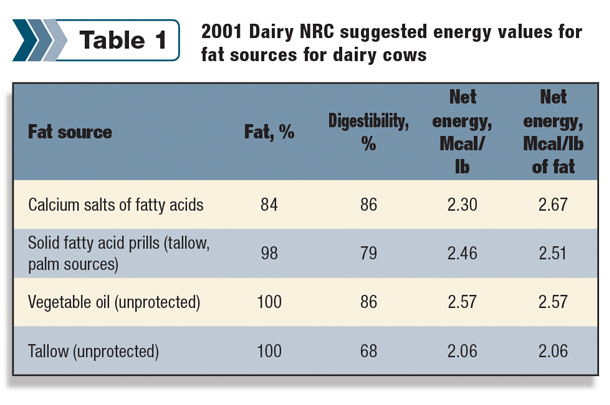Today, we know a lot more about feeding fat than in the past. Unfortunately, selecting a fat source has not gotten any easier due to the growing number of supplemental fat products on the market. In fact, the majority of research and information available about feeding fat is now driven almost entirely by the commercial sector.
Although industry support has rapidly advanced our understanding of the role of fats in dairy nutrition, the marketing spin used to promote fat products sometimes makes it difficult to “see the forest for the trees.” What really is the economic value of rumen bypass fat?
Do fatty acids really play that much of a role in digestibility, reproduction or milkfat composition? Do cows prefer one bypass fat source to another? At times, the differences seem very subtle.
Many excellent general reviews of feeding fat to dairy cattle are available in printed literature and on the Internet. Compared with natural high-fat feeds, the cost of rumen bypass fat sources is very significant. Consequently, this article will focus primarily on:
- Why and when to feed supplemental fat
- Understanding the key differences among types of bypass fats
- Why fatty acids matter
Why feed fat?
In North America, most dairy cows have very high levels of milk production and would classify as “energy-challenged.” In early lactation, most cows will actually lose a considerable amount of weight because energy intake is less than that needed to meet the nutrient demands of milk production. As a result, the cow mobilizes body nutrient reserves, particularly body fat, to meet energy demand.
Considering its energy density, fat is a logical choice for boosting ration energy density. In fact, 1 pound of fat is roughly equivalent to the energy value of 3 pounds of shelled corn. The additional advantage of feeding supplemental fat is: The detrimental effects (including acidosis and laminitis) of feeding high levels of grain can be avoided.
Improving forage quality will always be the most economical and nutritionally safe way to balance high-production rations. However, supplemental fat almost always has a place in the ration when high-quality forages are not readily available.
Why limit natural, high-fat feeds?
Most dietary fat is in the form of triglycerides – three fatty acids connected to a glycerol molecule. It is the fatty acids that create a special problem for rumen bacteria. Although the bacteria can use the glycerol portion of the triglyceride for energy, they cannot ferment the fatty acid chains and simply release them into the rumen environment. The unsaturated vegetable fatty acids are inhibitory to many microbial species.
Although rumen bacteria can “detoxify” the unsaturated fatty acids by changing the chemical form (saturating them), this results in the production of “trans fatty acids” that are well known to have direct effects on the mammary gland that reduce milkfat production.
Therefore, as fat availability (unprotected) in the rumen increases, fibre digestion decreases and milkfat levels go down. Just 2 percent vegetable oil in the diet can cause dramatic changes in milkfat production.
Limiting the negative impact of natural feed fats in the rumen (i.e., fats coming from vegetable sources such as whole or roasted soybeans, whole cottonseed and distillers grains) is the basis for the sometimes complex restrictions related to feeding supplemental fat to dairy cattle.
Feeding natural fat sources at levels higher than recommended is almost always a mistake. Once feeding limits on starch and natural fat are reached, rumen bypass fats become a logical option to push ration energy levels higher.
What is a rumen bypass fat?
Rumen bypass or “protected” fats are essentially dry fats processed to be easily handled and mixed into all animal feeds. Because dry fats naturally have high melting points, they are mostly insoluble at rumen body temperature. In essence, dry fats are not as much “protected” as completely insoluble in the rumen, so they have small impacts on rumen fermentation.
Today, there are only three methods of producing dry fats for animal feeds. The method that produces the least desirable product for the cow, partial hydrogenation of tallow, is seldom used for dairy rations and will not be discussed further. One acceptable method for producing a bypass fat is to hydrolyze the fatty acids from palm oil or tallow, partially hydrogenate them and then spray-chill them in a tower to form fatty acid prills.
The dominant bypass fat technology is still the reaction of vegetable fatty acids with calcium oxide to form insoluble calcium soaps. Within the feed industry, these calcium soaps, or salts, appear on feed labels as “calcium salts of long-chain fatty acids.” Because free fatty acids are a major byproduct of producing palm oil for human food, almost all calcium salts produced worldwide come from palm oil fatty acids.
Because large amounts of dietary fat will eventually reduce feed intake of any animal species, feeding guidelines for feeding bypass fats are generally in the range of 200 to 600 grams per cow daily. Performance goals and ration cost will generally be the dominant factors in determining how much bypass fat to feed.
Purchasing bypass fats ... what really matters?
Digestibility determines energy content
The energy content of a bypass fat is determined almost entirely by its intestinal digestibility. According to the 2001 Dairy NRC (Table 1), the intestinal digestibility of pure fat sources can vary considerably.

Extensive research suggests reduced fat digestibility is most closely associated with a high stearic acid content. Vegetable fats, including palm fatty acid salts, have much lower stearic acid levels than animal fats or bypass fat derived from tallow.
Calcium salts of long-chain fatty acids (usually assumed to be derived from palm oil processing) have the highest intestinal digestibility among rumen bypass fats. Because of their calcium content, calcium salts of fatty acids contain slightly less total fat than other rumen bypass fats. However, because of their high digestibility, calcium salts also have the highest net energy content per unit of fat.
Because it is still primarily energy being purchased, it is important to understand how different types of bypass fats differ in their energy content. In addition, when comparing fat sources, it is critical to make “apples to apples” comparisons in energy levels.
That is, all reported energy levels should come from the same database and be calculated in the same way. For example, the 2001 NRC Nutrient Requirements for Dairy Cattle would be considered the “gold standard” for energy values for feedstuffs fed to dairy cattle.
It is very important to understand that the 2001 Dairy NRC changed the method of calculating the energy value of feeds and moved the energy values for most dairy feedstuffs down. The 2001 Dairy NRC indicated calcium salts of palm fatty acids have a typical net energy of lactation value of 2.3 Mcal per pound.
On literature pieces for bypass fat products, suppliers often report outdated or independently calculated energy values. These are often unrealistically high when compared to other high-fat feedstuffs. Meaningful comparisons are easier to make when using the NRC values, such as those shown in Table 1. In the table, vegetable fatty acid (high-palmitic acid) and tallow fatty acid prills are assumed to have similar digestibilities.
Fatty acids should be considered
Although the primary reason for feeding fat is for its energy density, it is becoming increasingly evident that essential fatty acids supplied by fat may have an important role in the nutrition of the high-producing cow. Unfortunately, fatty acid metabolism in the dairy cow is quite complex.
It may be some years before it is accurately known which and how much fatty acid to feed in order to manipulate milk composition, reproduction or other health or metabolic parameters in the cow. However, a few generalizations can be made regarding fatty acids:
- The natural fatty acid profile of vegetable fats has more value than that of animal fats, largely because of their content of the essential fatty acids, linoleic and linolenic acid.
- Bypass fats with higher levels of stearic acid may have slightly reduced digestibility.
- Fractionated vegetable fats with high levels of palmitic acid (greater than 80 percent), referred to as “high-palm” fats, may increase milk fat production to a higher level than other fat sources.
Palatability
Different classes of bypass fats may differ slightly in their palatability. Calcium salts of palm oil fatty acids have a very pungent odour and a slightly bitter taste, and there is evidence that cows can detect these fats when they are initially added to the ration.
Therefore, animals that have not had previous exposure to these fats may require an adaptation period. In addition, when calcium salts are fed, greater care should be taken to ensure these products are thoroughly incorporated into the ration so feed intake is not affected. In general, palatability should not be considered criteria for determining which protected fat source to purchase unless that fat source will be used at low levels in a transition ration or perhaps top-dressed onto the ration.
Physical form
Most classes of bypass fats are handled and mixed into dairy feeds with relative ease. Calcium salts of palm oil fatty acids tend to be favoured during very hot weather because flowability of soy-based calcium salts and prilled fats can be greatly reduced during warm weather. Particle size could be criteria for purchasing a specific class or brand of protected fat depending on the application.
Finer particle sizes may improve mixability of the salts within mineral mixes but may lead to reduced flowability or excessive dustiness in feedmills or mixer wagons. For example, calcium salts of palm fatty acids tend to be slightly dustier but more flowable than prilled fatty acid products.
Special applications of protected fat
Fat and hot weather
It makes sense that enhancing ration energy density by utilizing fats could be particularly beneficial during hot weather. However, research on the effects of feeding high-fat rations during hot weather have yielded inconsistent results. This is probably because it is very easy to overfeed unprotected fat sources, such as whole oilseeds, when the cow’s feed intake is significantly reduced due to heat stress.
If fat is overfed, then the negative effects of the fat on fibre digestibility will negate any possible gains with increased ration density. Because bypass fats do not affect rumen fermentation, they should probably make up a greater percentage of the total fat included in the ration during hot weather.
Improving reproductive performance
It is well accepted that supplemental fat benefits herd reproductive performance by minimizing bodyweight loss and accelerating bodyweight gain after calving. In addition, research strongly suggests unsaturated vegetable fatty acids could have additive effects on reproductive parameters in the cow, including follicular size and hormone patterns.
There are several bypass fat products on the market that are promoted for the reproductive benefits of higher levels of specialty fatty acids, such as linolenic acid, DHA or EPA. This approach to improving reproductive performance makes biological sense and there are controlled trials to support possible benefits; however, the performance of these products in the field has been mixed.
Conclusion
Selecting the best value in bypass fat is not an easy task because of the growing number of available fat sources. In addition, we now understand that complicated factors, such as fatty acid composition, can also create potentially greater value for some bypass fats.
Non-nutritional factors that will sometimes influence which bypass fat to purchase include level of supplier trust, storage facilities and mixing requirements, and ration feeding method. To assure obtaining the greatest economic value from a bypass fat, nutritional factors should be considered in this order:
- Digestibility – Vegetable sources are higher than animal sources.
- Fatty acids – Essential fatty acids and high levels of palmitic acid are possible focus areas.
- Palatability – Care should be observed to assure that subtle palatability differences do not affect performance of bypass fats on the farm. PD

-
Dwain Bunting
- Ruminant Technical Manager
- ADM Animal Nutrition
- Email Dwain Bunting








